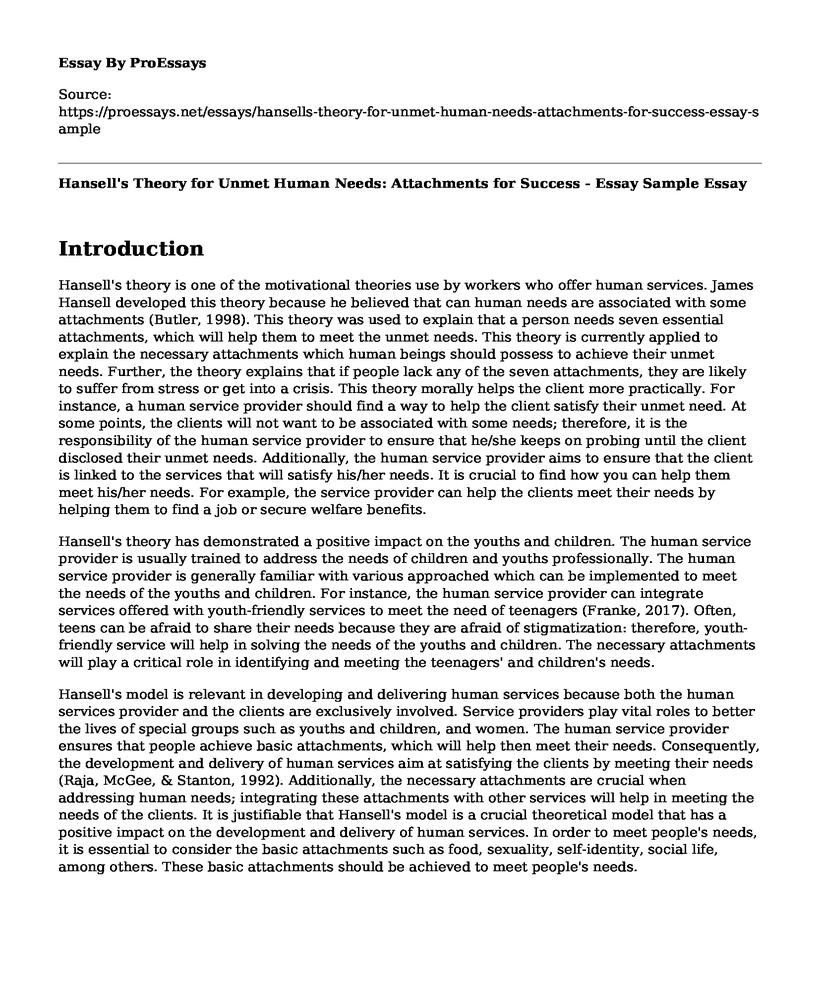Introduction
Hansell's theory is one of the motivational theories use by workers who offer human services. James Hansell developed this theory because he believed that can human needs are associated with some attachments (Butler, 1998). This theory was used to explain that a person needs seven essential attachments, which will help them to meet the unmet needs. This theory is currently applied to explain the necessary attachments which human beings should possess to achieve their unmet needs. Further, the theory explains that if people lack any of the seven attachments, they are likely to suffer from stress or get into a crisis. This theory morally helps the client more practically. For instance, a human service provider should find a way to help the client satisfy their unmet need. At some points, the clients will not want to be associated with some needs; therefore, it is the responsibility of the human service provider to ensure that he/she keeps on probing until the client disclosed their unmet needs. Additionally, the human service provider aims to ensure that the client is linked to the services that will satisfy his/her needs. It is crucial to find how you can help them meet his/her needs. For example, the service provider can help the clients meet their needs by helping them to find a job or secure welfare benefits.
Hansell's theory has demonstrated a positive impact on the youths and children. The human service provider is usually trained to address the needs of children and youths professionally. The human service provider is generally familiar with various approached which can be implemented to meet the needs of the youths and children. For instance, the human service provider can integrate services offered with youth-friendly services to meet the need of teenagers (Franke, 2017). Often, teens can be afraid to share their needs because they are afraid of stigmatization: therefore, youth-friendly service will help in solving the needs of the youths and children. The necessary attachments will play a critical role in identifying and meeting the teenagers' and children's needs.
Hansell's model is relevant in developing and delivering human services because both the human services provider and the clients are exclusively involved. Service providers play vital roles to better the lives of special groups such as youths and children, and women. The human service provider ensures that people achieve basic attachments, which will help then meet their needs. Consequently, the development and delivery of human services aim at satisfying the clients by meeting their needs (Raja, McGee, & Stanton, 1992). Additionally, the necessary attachments are crucial when addressing human needs; integrating these attachments with other services will help in meeting the needs of the clients. It is justifiable that Hansell's model is a crucial theoretical model that has a positive impact on the development and delivery of human services. In order to meet people's needs, it is essential to consider the basic attachments such as food, sexuality, self-identity, social life, among others. These basic attachments should be achieved to meet people's needs.
Conclusion
In conclusion, Hansell's model in a crucial theoretical model that can be used during the development and delivery of human services. The model helps the human service providers to identify various needs and find the best ways to help the clients to meet their needs through the achievement of the seven basic attachments.
References
Butler, J. (1998). Analysis of the core commentary on papers by James H. Hansell and Dianne Elise.
Franke, U. (2017). Inter-organizational relations: five theoretical approaches. In Oxford Research Encyclopedia of International Studies.
Raja, S. N., McGee, R., & Stanton, W. R. (1992). Perceived attachments to parents and peers and psychological well-being in adolescence. Journal of youth and adolescence, 21(4), 471-485.
Cite this page
Hansell's Theory for Unmet Human Needs: Attachments for Success - Essay Sample. (2023, Feb 27). Retrieved from https://proessays.net/essays/hansells-theory-for-unmet-human-needs-attachments-for-success-essay-sample
If you are the original author of this essay and no longer wish to have it published on the ProEssays website, please click below to request its removal:
- Research and Inquiry in My Workplace Paper Example
- Research Paper on Educational and Professional Goals and the DNP Degree
- Work and Employment - Essay Sample
- Essay Sample on Mental Health: Essential for Adults & Children
- Overcoming Fear of Public Speaking: My Story - Essay Sample
- Essay Example on Understanding Conflict Theory: Causes & Implications of Social Conflicts
- Free Paper Sample: Behaviour Problems of Dogs and Cats







